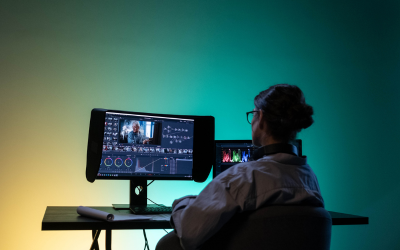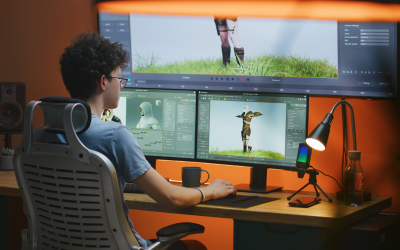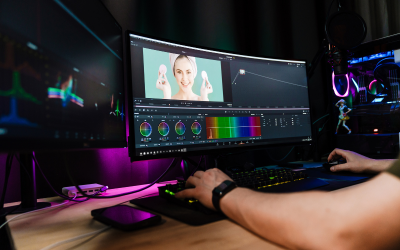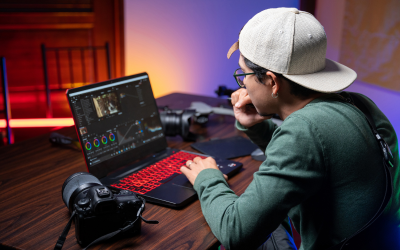Course description
Highlights:-
Introduction to VFX & Animation: Learn the fundamentals of visual effects and animation, includingthe types, tools, and processes involved in creating dynamic visuals. - VFX Techniques & Software: Get hands-on training in industry-standard software like Adobe After
Effects, Autodesk Maya, Nuke, and Houdini. - 3D Animation & Modeling: Master the creation and animation of 3D models, character rigging, andrendering processes. - Compositing & Motion Graphics: Understand the art of compositing, blending live-action footagewith computer-generated imagery (CGI), and creating dynamic motion graphics. - VFX in Film & Games: Explore how VFX and animation are applied in different industries suchas film, TV, advertising, and gaming.
Course Objective:
By the end of this course, you will be able to: - Understand the principles of VFX and animation, and their integration into visual media. - Master industry-standard tools and software for creating VFX and animation. - Create realistic 3D models, characters, and environments for animation. - Implement special effects, motion graphics, and compositing techniques in your work. - Develop high-quality animated sequences for film, video games, and advertisements. - Collaborate on a project and deliver a complete visual effects animation portfolio.
Course Structure:
1. Introduction to VFX & Animation
- Overview of VFX and Animation: Key concepts and their role in visual storytelling
- Types of Animation: 2D, 3D, stop-motion, and motion graphics
- History and evolution of VFX and animation in film and media
- Introduction to industry-standard software: Adobe After Effects, Maya, Nuke, Houdini
2. VFX Techniques & Tools
- The basics of visual effects: Rotoscoping, motion tracking, and green screen
- Understanding VFX workflow and pipeline in the production process
- Techniques for creating explosions, fire, smoke, and other realistic special effects
- Introduction to software for VFX compositing and simulation: Nuke and Houdini
3. 3D Animation & Modeling
- Understanding the fundamentals of 3D animation: Timing, spacing, and keyframes
- Learning 3D modeling techniques for character and environment design
- Rigging and skinning characters for animation
- Texturing, lighting, and rendering 3D models
- Animation principles: Squash and stretch, anticipation, follow-through, etc.
4. Compositing & Motion Graphics
- Introduction to compositing and its role in VFX production
- Layering 3D elements over live-action footage for seamless integration
- Motion graphics design: Creating dynamic titles, lower-thirds, and animated logos
- Working with Adobe After Effects and Nuke for advanced compositing techniques
5. VFX in Film & Television
- The role of VFX in modern filmmaking: Visual storytelling and CGI in blockbuster movies
- Creating visual effects for different genres: Action, fantasy, horror, and sci-fi
- Case studies of iconic VFX sequences in film history
- Workflow for integrating VFX into a film or TV show, from pre-production to post-production
6. VFX in Video Games & Interactive Media
- Introduction to VFX in gaming: How to create interactive animations and effects
- Working with game engines like Unity and Unreal Engine for VFX and animation
- Creating real-time VFX for video games: Particle systems, lighting, and environmental effects
- Motion capture technology and its application in game animation
7. Advanced VFX & Animation Topics
- Simulation techniques: Fluid, smoke, fire, and destruction effects
- Character animation: Advanced rigging, facial animation, and lip-syncing
- Virtual reality (VR) and augmented reality (AR) applications in VFX
- Procedural animation and scripting in software like Houdini
- Collaborative workflows and project management in VFX studios
8. Portfolio Development & Final Project
- Building a professional VFX and animation portfolio
- Working on individual or group projects to showcase skills
- Presenting your VFX + animation work to potential clients or employers
- Preparing for industry-specific job roles: VFX artist, animator, compositor, and motion graphic
designer
Learning Methodology:
- Interactive Lectures: Structured lessons delivered by experienced VFX artists and animators. - Hands-on Practice: Work on real-world projects using industry-standard tools and software. - Assessments & Quizzes: Regular assignments and tests to reinforce learning. - Live Sessions: Participate in live Q&A and feedback sessions with instructors. - Discussion Forums: Engage with peers to solve problems and share creative ideas.
Who Should Enroll:
- Aspiring VFX artists and animators seeking to break into the industry
- Film and television production professionals interested in VFX and animation techniques
- Game developers looking to incorporate VFX and animation into their games
- Graphic designers and motion graphics artists seeking to expand their skills
- Students or individuals aiming to develop a career in animation, VFX, or digital media production
This VFX + Animation course is the perfect learning path for anyone looking to explore the worldof
visual effects and animation, whether you're looking to enter the film, television, gaming, or
advertising industries. By mastering the core principles and industry-standard tools, you'll be readyto create captivating visual content that pushes creative boundaries.














